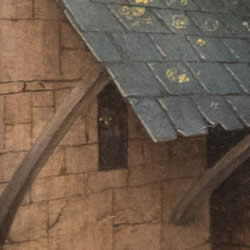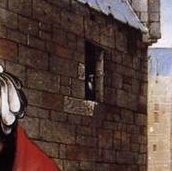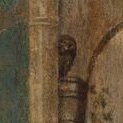Pygmy Owl from The Garden of Earthly Delights Museo del Prado, Madrid, Spain Bosch's Owls An informal analysis
Copyright 2015 by Lee van Laer
Hieronymus Bosch included tiny owls in most of his paintings. They are not in all the paintings; but, I believe, they have a specific significance.
The owl that Bosch most consistently paints is a diminutive spotted owl. This owl is almost without a doubt the European or Eurasian pygmy owl.
Pygmy Owl from The Wayfarer Museum Boijmans van Beunigen, Rotterdam, Netherlands
Pygmy Owl, Temptation of St. Anthony Museu Nacional de Arta Antiga, Lisbon
The "signature" owls in Bosch paintings are generally hidden, and difficult to spot. The pygmy owl above is, unusually, one of two owls in this painting (see below.) The fact that it is partially concealed alludes, as it does in all cases, to a hidden wisdom.
Another owl that crops up in several paintings is the barn owl, another owl that would have been well familiar to rural late Middle Ages and early Renaissance households. Because it preys on vermin, it would also carry positive connotations:
Barn Owl, Temptation of St. Anthony Museu Nacional de Arta Antiga, Lisbon
Barn Owl, The Conjurer Musee Municipal, St. Germain en Laye
Why, we might ask, all the owls? They seem very nearly frivolous afterthoughts, working as they do in the dark places, windows, tree branches, and margins of the paintings. In addition to their marginalized presence in so many of the works, they convey a touch of sensitivity, intimacy, and humor — as though their tiny presence somehow supervised the goings-on in the paintings. Sometimes, as in the triptych of St. Uncumber, they even appear embroidered on garments:
Owl from the Tryptich of St. Uncumber Gallerie dell-Accademia, Venice, Italy
Or perched on the head of a nun:
Owl from Hermit Saints Tryptich Gallerie dell-Accademia, Venice, Italy
While the owls, considered on the whole, are a lighthearted touch, this particular symbol is not just a little jest for the viewer to enjoy, and was chosen quite intentionally by Bosch. It is, so to speak, his signature motif. If an owl is lacking in a Bosch painting, that, too, means something.
To understand what he was getting at, we need to refer to a classic work on animal symbolism in European art, the Bestiary of Christ, by Louis Charbonneau-Lassay. He covers the owl on pages 209 to 213.
The owl, he advises us, "symbolizes the mystery of the shadows of the night." While the owl itself is, overall, considered a creature of ill omen in traditional folklore, the one that, according to Charbonneau-Lassy, inspire's sympathy is the chevechette, the pygmy owl, who accompanies the late traveler along country roads. The owl that Bosch chose, in other words, is the one which was "looked upon with great favor in Athens as well as the rest of the ancient world."
Owl from The Haywain Museo del Prado, Madrid
He goes on to explain, "In the bird that sees clearly in the dark when all others are blind, and when it is hunted has the good sense and the caution to remain hidden all day, the Greeks saw a symbol in which were united the three qualities of wisdom, knowledge, and Prudence." It is connected with Athena, the goddess of wisdom; And, he explains, "in the main the owl was still regarded in the medieval times from the point of view of the ancients. Especially in the monasteries, where all day long the bird keeps to its place on the wall or in the hollow tree, it was taken as the sign of meditation."
Owl from St. Jerome in Prayer Museum of Fine Arts, Ghent, Belgium
Some have claimed that Bosch use the owl as a symbol of evil; and, given the creature's long-standing status as a representative of the agents of darkness, the assignation is plausible. But I think it is clear enough, looking at the many different owls that Bosch painted, that he had no such intention in mind —absolutely not. The owl that he chose is, in folklore, an appealing and benevolent creature; and the owl presides over the paintings with an inner, or esoteric, significance as the charge d'affaires, host, of all that proceeds under his watchful eyes. It can, we are reminded, see clearly in the dark when all others are blind. What better indicator of the fact that Bosch was conveying inner visions of the spiritual life?
In order to appreciate the wide range of paintings including owls, below is a catalog, which is not complete. In some cases, the resolution of paintings available online for digital reproduction is too poor to examine and close detail; and in many cases, paintings have been damaged, cut down, and represent what are, at best, fragmentary records of the original piece. Nonetheless, every Bosch painting including an owl is what I would call a wisdom painting: that is, there is an esoteric teaching buried beneath the bizarre and exotic symbolism, which is, if properly understood, not so bizarre or exotic after all.
Beginning with the owl that lurks at the base of the divine fountain of heavenly inspiration, the Garden of Earthly delights introduces multiple owls, rather than the single owl .
Oversized Owl, The Garden of Earthly Delights Museo del Prado, Madrid, Spain
The oversized owl, like other exaggerated birds in the center of the painting, represents an imaginary quality — in this case, imaginary wisdom. ( See the comprehensive commentary on the painting for further explanations.)
Magical Owl, The Garden of Earthly Delights Museo del Prado, Madrid, Spain
This owl, also found in the center of the painting, wards and protects a dervish—like dancer, immune to the vines and cherries of temptation that surround him.
Owl from Adoration of the Magi Museo del Prado, Madrid, Spain
Owl from Adoration of the Magi Metropolitan Museum, New York, USA
It's not uncommon, however, for owls to lurk in the darkest eaves of the painting, where the viewer is challenged to find them. In these two paintings — both paintings that figure the Christ child — the owl is aggressively played down, nearly invisible. This deemphasizing may well have been intentional. It's striking that the majority of paintings featuring the life of Christ do not have owls in them. It's as though Bosch felt that it would be presumptuous to include indications of wisdom teachings in paintings depicting Christ— who embodies, after all, the wisdom teaching.
In some cases, paintings have deteriorated enough that the owls are even difficult to make out:
Owl in Ecce Homo (in window) Stadel Museum, Frankfurt, Germany
Owl in Ecce Homo (in window, hard to see) Boston Museum of Fine Arts, USA
Owl from Marriage at Cana Museum Boijmans van Beunigen, Rotterdam, Netherlands
My suspicion is that some paintings are so old or so badly damaged or "restored" that owls which were originally there may be missing. In addition, there are a number of paintings, such as the allegory of glutton and lust, head of a woman, and so on, which are fragments, leaving us with few clues as to whether or not owls were included. One notable case where there is no owl, but the pieces definitely part of a wisdom painting, is Death and the Miser, in the National Gallery of Art in Washington DC, which is known to be associated with Ship of Fools as part of what was originally a triptych. The requisite owl appears in Ship of Fools, indicating that the painting is indeed a wisdom painting — which is, after all, amply evident from the subject matter.
Owl from Ship of Fools Louvre, Paris, France
Bosch's paintings were, of course, enormously popular; and when copyists rendered them, the owls come along.
Owl from The Last Judgment Copy of the Bosch painting in the Academy of Fine Arts, Vienna by Lucas Cranach the Elder Gemaeldegalerie, Berlin, Germany
I chose this particular picture because the online versions of the painting from the Academy of fine arts are in terrible, very low resolution, and it is nearly impossible to see the owl. This problem ought to be rectified by the institution. Another example of an owl found in a copy of a work which no longer exists, but was rendered by another artist, is below.
Owl from The Concert in the Egg Palais des Beaux-Arts de Lille, France
In summary, I believe that Bosch used owls as a specific indicator for his wisdom paintings: that is, when his art encoded special esoteric Christian teachings, which were taught in the religious society of the Virgin he was enrolled in, he included an owl as a key.
Very nearly half of their anonymous Bosch paintings that are still with us today have owls in them. Even more tellingly, all of the paintings with owls in them there have other significant and consistent symbolic relationships that Bosch employed over and over again to convey his message.
This message was, in my opinion, a deeply revelational and deeply Christian one; the fact that he used striking an unusual imagery to bring his message is simply a sign of his agile and enormously imaginative mind, not some doctrinal aberration. He painted mysteries; he painted Christian ministries.
The owl serves as the perfect motif of the creature who can see in the darkness, where others are blind.
|
||
|







